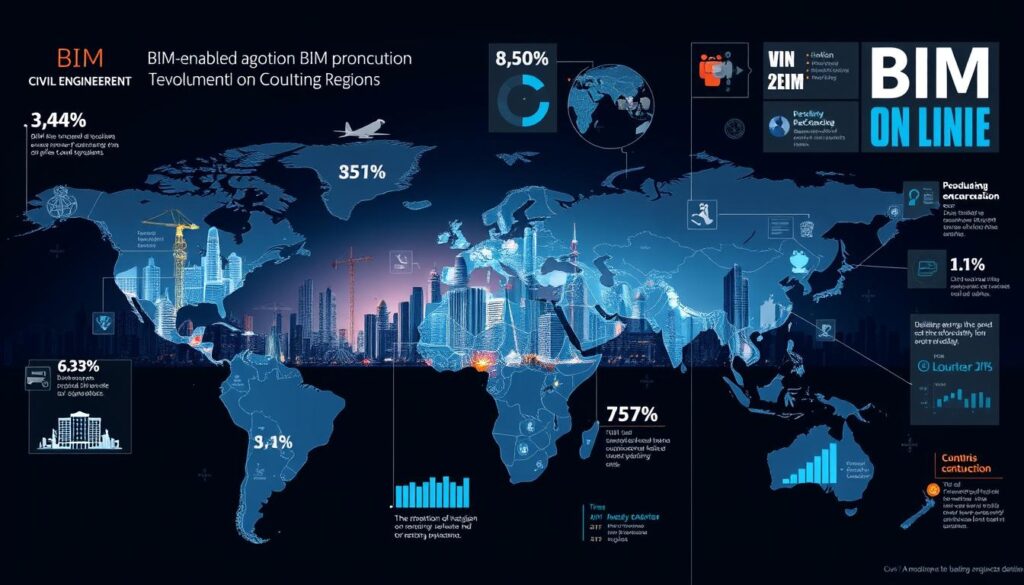The civil engineering industry is undergoing a significant transformation, with Building Information Modeling (BIM) at the forefront of this change. By creating detailed digital models, BIM is revolutionizing the way projects are designed, executed, and managed.
This technology is enhancing collaboration among stakeholders, improving project efficiency, and reducing costs. As a result, the industry is witnessing a significant shift towards more sustainable and cost-effective practices.
Key Takeaways
- BIM is transforming the civil engineering industry through digital modeling.
- Enhanced collaboration is a key benefit of BIM adoption.
- Project efficiency and cost reduction are significant outcomes of BIM implementation.
- BIM is driving the industry towards more sustainable practices.
- The technology is improving decision-making throughout the project lifecycle.
Understanding BIM: Definition and Importance
BIM technology is transforming the way civil engineers design, build, and manage infrastructure projects. By leveraging digital processes, BIM enhances the efficiency, productivity, and sustainability of construction projects.
What is BIM?
BIM stands for Building Information Modeling, a digital process that involves creating and managing intelligent 3D models of infrastructure projects. It integrates comprehensive data, including geometric, spatial, and environmental information, to provide a holistic understanding of the project. BIM technology enables civil engineers to visualize, simulate, and analyze various project scenarios, facilitating informed decision-making.
The Role of BIM in Civil Engineering
In civil engineering, BIM plays a crucial role in enhancing collaboration among stakeholders, improving project efficiency, and reducing costs. By utilizing BIM, engineers can create detailed digital models that help identify potential issues early in the project lifecycle, thereby minimizing risks and optimizing project outcomes. The use of BIM technology in civil engineering also promotes sustainability by enabling the analysis of energy efficiency and environmental impact.
The importance of BIM in civil engineering cannot be overstated. As infrastructure projects become increasingly complex, the need for advanced digital tools like BIM continues to grow. By adopting BIM, civil engineers can stay at the forefront of innovation, delivering projects that are not only more efficient and cost-effective but also more sustainable.
Historical Context of BIM in Construction

BIM’s history is marked by pivotal milestones that have shaped its development and integration into civil engineering practices. Since its emergence, BIM has evolved significantly, influenced by advancements in technology and changing industry needs.
Evolution of Building Information Modeling
The concept of BIM began taking shape in the 1970s, with the introduction of early computer-aided design (CAD) systems. These initial systems laid the groundwork for the sophisticated BIM software for civil engineering used today. Over the years, BIM has transitioned from a novel approach to a standard practice in the construction industry.
As noted by Chuck Eastman, one of the pioneers in BIM, “BIM is more than just a 3D model; it’s a process that involves the creation and management of digital representations of physical and functional characteristics of places.” This perspective highlights the depth of BIM’s impact on construction practices.
“The future of construction is not just about buildings, it’s about the information that drives their creation.” –
Key Milestones in BIM Development
The development of BIM has been marked by several key milestones, including the introduction of new software capabilities and industry-wide adoption standards.
| Year | Milestone | Description |
|---|---|---|
| 1970s | Introduction of CAD | Early computer-aided design systems emerge, laying the foundation for BIM. |
| 1990s | BIM Software Development | First BIM software solutions are developed, offering enhanced modeling capabilities. |
| 2000s | Industry Adoption | BIM begins to see widespread adoption across the construction industry. |
For a more detailed exploration of BIM’s history and evolution, visit Infotech Inc.’s blog on the history of, which provides insights into the significant advancements in BIM technology.
The evolution of BIM is a testament to the industry’s ability to adapt and innovate. As BIM software for civil engineering continues to advance, it is likely to play an even more critical role in shaping the future of construction.
Benefits of BIM in Civil Engineering
By leveraging BIM, civil engineers can now manage projects more effectively, improving overall project outcomes. BIM technology has become a cornerstone in modern civil engineering, offering a multitude of benefits that transform the way projects are executed.
Enhanced Collaboration Among Stakeholders
One of the significant BIM benefits in construction is the enhancement of collaboration among various stakeholders. BIM facilitates a common data environment where all parties can access and share information, leading to better coordination and reduced misunderstandings.
Improved communication is a direct result of this collaborative environment, ensuring that all stakeholders are on the same page throughout the project lifecycle.
Improved Project Efficiency and Productivity
BIM technology significantly improves project efficiency by allowing for the detailed planning and simulation of construction processes. This leads to improved project efficiency as potential issues are identified and addressed early in the design phase.
- Streamlined workflows
- Reduced construction delays
- Enhanced productivity through detailed planning
Cost Savings and Budget Management
The adoption of BIM also results in substantial cost savings. By identifying potential issues early, projects can avoid costly rework and minimize budget overruns. Effective budget management is thus a key benefit of BIM in civil engineering.
Through the use of BIM, civil engineers can better manage project finances, ensuring that projects are completed within budget and on schedule.
BIM vs. Traditional Design Methods

The advent of Building Information Modeling (BIM) has revolutionized the civil engineering industry by offering a more sophisticated alternative to traditional design methods. BIM’s advanced capabilities are transforming the way projects are designed, executed, and managed.
Key Differences between BIM and 2D CAD
One of the primary distinctions between BIM and traditional 2D CAD lies in their approach to design and data management. While 2D CAD focuses on creating detailed drawings, BIM generates intelligent 3D models that integrate comprehensive project data. This enables enhanced collaboration among stakeholders and improves project efficiency.
- BIM provides a more detailed and accurate representation of the project.
- It facilitates better data management and integration.
- BIM enhances collaboration among project stakeholders.
For instance, a study on how AI is transforming civil engineering highlights the potential of BIM in leveraging advanced technologies for improved project outcomes.
The Shift from Paper to Digital Workflows
The transition from traditional paper-based workflows to digital BIM processes is a significant step forward in civil engineering. This shift not only reduces paperwork but also streamlines project workflows, making them more efficient and less prone to errors.
- Digital workflows enable real-time collaboration and data sharing.
- BIM reduces the reliance on paper, minimizing errors and improving productivity.
- The use of digital models facilitates better visualization and analysis of project components.
By adopting BIM, civil engineering projects can benefit from improved data integration, enhanced collaboration, and more efficient project management. As the industry continues to evolve, the adoption of BIM is expected to become more widespread, driving further innovation and improvement in civil engineering practices.
Implementing BIM in Civil Engineering Projects
To successfully integrate BIM into civil engineering projects, professionals must understand its applications and challenges. BIM is not just a tool but a process that involves significant changes in how projects are planned, executed, and managed.
Steps for Successful BIM Adoption
Successful BIM adoption requires careful planning and execution. The first step is to define the project’s BIM objectives and ensure they align with the overall project goals. This involves identifying the specific uses of BIM, such as clash detection, construction sequencing, or facility management.
Another crucial step is providing adequate training and support to the project team. This includes not only technical training on BIM software but also understanding the workflows and processes associated with BIM. Investing in the right technology and infrastructure is also vital to support BIM implementation.
Challenges of Integrating BIM
Despite its benefits, integrating BIM into civil engineering projects comes with its challenges. One of the significant hurdles is resistance to change among professionals who are accustomed to traditional methods. Overcoming this resistance requires a cultural shift within the organization, emphasizing the benefits of BIM, such as improved collaboration and efficiency.
Another challenge is the significant upfront investment required for BIM adoption, including costs associated with software, hardware, and training. However, the long-term benefits, such as cost savings and improved project outcomes, often justify this initial investment.
By understanding these challenges and taking proactive steps to address them, civil engineering professionals can successfully implement BIM in their projects, leading to improved outcomes and enhanced collaboration among stakeholders.
Technology Behind BIM: Software and Tools

The technology behind Building Information Modeling (BIM) is revolutionizing the civil engineering industry with its advanced software and tools. BIM tools for civil engineers have become indispensable in modern construction projects, enhancing collaboration, precision, and productivity.
Popular BIM Software in the Industry
Several BIM software solutions have gained prominence in the civil engineering sector. Autodesk Revit, Bentley Systems’ OpenRoads, and Tekla Structures are among the most widely used applications. Each of these platforms offers unique features and capabilities tailored to different aspects of civil engineering projects.
For instance, Autodesk Revit is renowned for its comprehensive building design and documentation capabilities. It allows engineers to create detailed models and collaborate effectively with other stakeholders. On the other hand, Bentley Systems’ OpenRoads is designed for the design, survey, and construction of roads and other infrastructure projects, offering advanced tools for site design and analysis.
Comparing Different BIM Platforms
When comparing different BIM platforms, several factors come into play, including functionality, ease of use, scalability, and compatibility with other software. The following table provides a comparative overview of some popular BIM software:
| BIM Software | Primary Use | Key Features |
|---|---|---|
| Autodesk Revit | Building Design and Documentation | Detailed modeling, collaboration tools, energy analysis |
| Bentley Systems’ OpenRoads | Infrastructure Design and Construction | Site design, survey tools, advanced analysis capabilities |
| Tekla Structures | Structural Engineering and Construction | Detailed structural modeling, fabrication, construction management |
As highlighted by experts, the choice of BIM software depends on the specific needs of the project. For more insights on the advantages of BIM in civil engineering, visit BIM Advantages for Civil Engineers.
In conclusion, the technology behind BIM is diverse and continually evolving, offering civil engineers a range of powerful tools to enhance their work. By understanding the capabilities and applications of different BIM software, professionals can make informed decisions and leverage these technologies to improve project outcomes.
Real-World Applications of BIM
Real-world applications of BIM in civil engineering demonstrate significant improvements in project outcomes and stakeholder collaboration. The technology has been successfully applied in various infrastructure projects, enhancing collaboration and project outcomes.
Case Studies of Successful BIM Projects
Several high-profile projects have showcased the potential of BIM in civil engineering. For instance, the London Crossrail project utilized BIM to manage complex tunnel boring operations, ensuring precise alignment and minimizing disruptions.
Another example is the Shanghai Tower, where BIM was used to optimize the construction process, resulting in significant cost savings and reduced environmental impact.
BIM in Infrastructure Development
BIM plays a crucial role in infrastructure development by enabling the creation of detailed digital models that facilitate better planning, design, and execution. This leads to improved project efficiency and reduced costs.
The application of BIM in infrastructure projects, such as roads, bridges, and tunnels, has shown promising results. It enhances collaboration among stakeholders and improves the overall quality of the project.
By adopting BIM, civil engineers and project managers can leverage data-rich models to make informed decisions, streamline processes, and deliver projects more efficiently.
The Role of BIM in Sustainable Engineering

The role of BIM in sustainable engineering is multifaceted, contributing to energy efficiency and the adoption of green building practices. By utilizing BIM technology, civil engineers can analyze and optimize building designs to minimize environmental impact.
Enhancing Energy Efficiency through BIM
BIM enables the creation of detailed digital models that can be used to simulate various energy-efficient design options. This capability allows engineers to optimize building performance and reduce energy consumption.
- Analyzing building orientation and layout to maximize natural light and reduce heating/cooling needs
- Simulating energy usage under different scenarios to identify the most efficient systems
- Integrating renewable energy systems into building designs
BIM’s Contribution to Green Building Practices
BIM contributes significantly to green building practices by facilitating the use of sustainable building materials and construction methods. It enables project stakeholders to make informed decisions about material selection and resource allocation.
- Evaluating the environmental impact of different building materials
- Optimizing material usage to minimize waste
- Facilitating the selection of materials with low embodied energy
By adopting BIM, the construction industry can move towards more sustainable practices, enhancing energy efficiency and reducing the environmental footprint of buildings. This not only benefits the environment but also contributes to the well-being of building occupants and the community at large.
Training and Education in BIM
As the construction industry continues to evolve, the demand for professionals skilled in BIM technology is on the rise. Effective BIM adoption requires a skilled workforce with the right training and certifications. This section discusses the importance of training and education in BIM, highlighting available courses, certifications, and strategies for building a BIM-ready workforce.
Courses and Certifications for Professionals
To meet the growing demand for BIM professionals, various courses and certifications have been developed. These programs cater to different levels of expertise, from beginners to advanced users. Some of the popular BIM certifications include:
- Autodesk Certified Professional: Revit for Architectural Design Exam
- Graphisoft Certified BIM Manager
- Certified BIM Manager by the American Institute of Constructors
These certifications not only enhance a professional’s skills but also increase their credibility in the industry. It’s essential for professionals to stay updated with the latest BIM software and technologies to remain competitive.
Building a BIM-Ready Workforce
Building a BIM-ready workforce requires a strategic approach. Organizations should invest in comprehensive training programs that cover the fundamentals of BIM, as well as advanced techniques. Some strategies for building a BIM-ready workforce include:
- Providing regular training sessions and workshops
- Encouraging collaboration and knowledge sharing among team members
- Hiring professionals with BIM certifications and experience
- Developing a mentorship program to guide new employees
By adopting these strategies, organizations can ensure that their workforce is equipped to handle BIM projects effectively. This, in turn, can lead to improved project outcomes, increased efficiency, and reduced costs.
The importance of continuous learning in BIM cannot be overstated. As BIM technology continues to evolve, professionals must stay updated with the latest developments and advancements. This can be achieved through ongoing training and education, as well as participation in industry events and conferences.
The Future of BIM in Civil Engineering

The future of civil engineering is intricately linked with the advancements in BIM technology, promising more integrated and automated processes. As the industry continues to evolve, the role of BIM in shaping project outcomes is becoming increasingly significant.
Predictions for BIM Technology Advancements
Several key trends are expected to drive the future of BIM in civil engineering. These include:
- Increased adoption of cloud-based BIM solutions
- Integration of AI and machine learning to enhance data analysis and project forecasting
- Enhanced collaboration tools for better stakeholder communication
- Advancements in BIM software for civil engineering, offering more sophisticated design and analysis capabilities
For more insights on the evolution of civil engineering, visit The Evolution of Civil Engineering.
The Impact of AI and Machine Learning on BIM
The integration of AI and machine learning into BIM is set to revolutionize the field by:
- Automating routine tasks, allowing for more focus on complex problem-solving
- Improving data accuracy and reducing errors through advanced analytics
- Enhancing predictive modeling to better anticipate project challenges
As BIM continues to advance, its synergy with AI and machine learning will be crucial in driving innovation and efficiency in civil engineering projects.
Regulatory and Compliance Issues with BIM
With BIM becoming increasingly integral to civil engineering, navigating the complex regulatory landscape is essential for project success. The use of BIM in infrastructure projects is not just a matter of adopting new technology; it also involves complying with various regulatory standards and guidelines that govern the industry.
Understanding Standards and Guidelines
BIM implementation is subject to a range of standards and guidelines that vary by country and region. For instance, in the United States, the National BIM Standard (NBIMS) provides a framework for BIM implementation across different project phases. Understanding these standards is crucial for ensuring that BIM projects meet regulatory requirements.
Key standards and guidelines include:
- ISO 19650, which provides an international framework for managing information over the whole life cycle of a built asset using BIM.
- The NBIMS, which offers a comprehensive framework for BIM implementation in the U.S.
- Local and national regulations that may dictate specific BIM requirements for public and private projects.
Navigating Legal Challenges in BIM
Beyond compliance with standards and guidelines, BIM also presents several legal challenges. These include issues related to data ownership, intellectual property rights, and liability in the event of project errors or omissions. As BIM models become more complex and integrated into project workflows, clarifying these legal aspects is vital.
Legal considerations in BIM involve:
- Defining data ownership and access rights among project stakeholders.
- Understanding the implications of BIM on contractual agreements and liability.
- Addressing the potential for disputes arising from the use of BIM models and data.
By understanding and addressing these regulatory and legal challenges, civil engineering professionals can more effectively leverage BIM to deliver successful projects that meet both regulatory requirements and client expectations.
Collaborative Work Processes in BIM

Collaboration and communication are key to unlocking the full potential of BIM in civil engineering. By facilitating a cohesive workflow, BIM tools enable teams to work together more effectively, ensuring that all stakeholders are on the same page throughout the project lifecycle.
A critical component of successful BIM implementation is the use of a common data environment (CDE). A CDE serves as a centralized platform where all project data is stored and managed, allowing teams to access the most up-to-date information at any given time.
Coordinating Teams through a Common Data Environment
The use of a CDE is vital in coordinating teams and enhancing collaboration in BIM projects. By having a single source of truth, teams can avoid data duplication and inconsistencies, reducing the risk of errors and miscommunication.
“A well-implemented CDE can significantly improve project outcomes by ensuring that all stakeholders have access to accurate and timely information.” – eLogicTech Blog
Key benefits of using a CDE include:
- Improved data management and organization
- Enhanced collaboration and communication among stakeholders
- Reduced risk of data duplication and inconsistencies
- Increased transparency and visibility into project progress
| Benefits of CDE | Description | Impact on Project |
|---|---|---|
| Improved Data Management | Centralized data storage and management | Reduced errors and improved data integrity |
| Enhanced Collaboration | Single source of truth for all stakeholders | Improved communication and reduced miscommunication |
| Increased Transparency | Real-time access to project data | Improved visibility into project progress |
The Importance of Communication in BIM Projects
Effective communication is critical in BIM projects, where multiple stakeholders are involved. Clear and timely communication helps to prevent misunderstandings and errors, ensuring that projects are completed on time and within budget.
By leveraging BIM tools for civil engineers, teams can enhance communication and collaboration, driving project success. As the industry continues to evolve, the importance of effective communication and collaboration in BIM will only continue to grow.
Ethical Considerations in BIM Implementation
Ethical issues surrounding BIM implementation, particularly in urban planning, are gaining significant attention. As BIM continues to play a crucial role in civil engineering and infrastructure development, addressing these ethical concerns becomes paramount.
The use of BIM involves the creation and management of digital models, which raises several ethical considerations. These include data privacy and security issues, as well as the ethical use of these digital models. Ensuring the privacy and security of project data is critical, as BIM models often contain sensitive information.
Data Privacy and Security Issues
BIM implementation involves the collection and storage of vast amounts of data, including project designs, timelines, and stakeholder information. This data is often sensitive and requires robust security measures to prevent unauthorized access or data breaches.
- Implementing robust access controls to ensure that only authorized personnel can access and modify BIM models.
- Using encryption to protect data both in transit and at rest.
- Regularly updating software and systems to patch vulnerabilities.
Ethical Use of Digital Models
The ethical use of digital models in BIM involves ensuring that these models are accurate, reliable, and used responsibly. This includes avoiding the misuse of models for purposes other than intended, and ensuring that stakeholders are aware of the limitations and potential biases of the models.
- Ensuring transparency in how digital models are created and used.
- Avoiding the manipulation of models for personal or organizational gain.
- Regularly validating models against real-world data to ensure accuracy.
By addressing these ethical considerations, the civil engineering industry can ensure that BIM is implemented in a way that is both responsible and beneficial. This includes fostering a culture of transparency, accountability, and continuous improvement.
International Perspectives on BIM Adoption

The global implementation of BIM is a multifaceted phenomenon, influenced by regional factors and industry needs. As countries around the world adopt BIM at varying rates, a diverse landscape of BIM practices has emerged.
BIM Trends in Different Countries
Different countries have unique approaches to BIM adoption, driven by local regulations, industry standards, and technological infrastructure. For instance, the United Kingdom has been at the forefront of BIM adoption, mandating its use in public projects. Similarly, countries like Singapore and Australia have implemented BIM standards to enhance construction efficiency.
- The UK’s BIM mandate has led to significant improvements in project delivery and collaboration.
- Singapore’s BIM guidelines focus on enhancing productivity and reducing construction costs.
- Australia’s adoption of BIM is driven by the construction industry’s need for improved project outcomes.
For a more detailed overview of global BIM adoption, you can refer to this comprehensive guide.
Lessons Learned from Global BIM Practices
The international experience with BIM offers valuable lessons for countries looking to adopt or enhance their BIM practices. Key takeaways include the importance of:
- Developing clear BIM standards and guidelines.
- Investing in training and education for industry professionals.
- Fostering collaboration among stakeholders through common data environments.
By examining global BIM trends and practices, countries can tailor their BIM adoption strategies to suit their specific needs, ultimately enhancing the efficiency and productivity of their construction industries.
Conclusion: Embracing BIM for Future Civil Engineering
The adoption of BIM technology is revolutionizing the civil engineering industry by enabling professionals to deliver projects more efficiently and sustainably. By leveraging BIM, engineers can achieve cost and time efficiencies by identifying issues early in the design phase, reducing errors, and improving construction accuracy.
Transforming the Industry
BIM’s detailed data enables better resource management, optimizing material usage, and reducing waste. As the industry continues to evolve, advancements in automation and artificial intelligence (AI) will allow engineers to make smarter decisions. To stay ahead, it’s essential to explore the full potential of BIM, as discussed in the article on BIM in Civil Engineering.
Embracing the Future
Industry professionals must embrace BIM technology to remain competitive. By doing so, they can improve collaboration, reduce costs, and contribute to more sustainable projects. The future of civil engineering depends on the successful integration of BIM, and it’s crucial for professionals to be at the forefront of this change.
